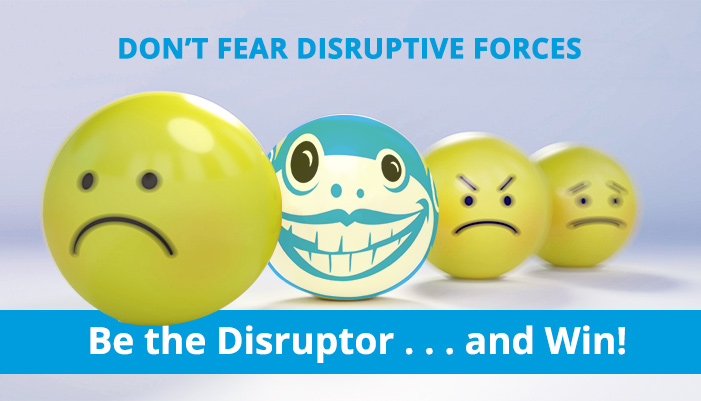In Star Trek lore, a “disruptor” is a Klingon weapon that, as its name suggests, “disrupts” a target’s cell structure, either inflicting heavy damage to said target or vaporizing it. In business, though, disruption doesn’t relate to inflicting mortal wounds, but rather to shaking up the status quo. And while the Klingons rarely won the day in their Star Trek universe, business disruptors tend to rule today’s marketplace.
MORE THAN THE LATEST BUZZWORD
Disruption is one of those business terms that has gained traction the last decade or so. You can hardly have a conversation about Apple during the Steve Jobs era without someone dropping the D-bomb. The iPod, iPhone, and iTunes are all classic examples of products that disrupted the marketplace—true innovations that rocked the traditional ways people bought and listened to their music, made and received phone calls, accessed the Internet and engaged in e-commerce, etc., etc.
The introduction of these three products by Apple truly disrupted the status quo. While Apple recognized a consumer need, rather than satisfy that need through tried and true methods, they thought outside the box and came up with alternate ways to scratch that itch. What’s more, not only did the iPod, iPhone, and iTunes products meet consumer demand—they changed it, driving demand for a product or service that people didn’t even know they needed or wanted. That’s true disruption!
BEWARE DISRUPTORS
When you’ve been in business for a long time, and you’ve been successful, you run the risk of your product or service becoming stale. It’s a matter of “what have you done for me lately.” Businesses that find themselves in this situation are ripe for a challenge from a marketplace disruptor.
A textbook example of this is Kodak, who reigned supreme in the film industry for decades only to go bankrupt with the advent of digital photography. The marketplace changed dramatically—it was disrupted—and Kodak failed to foresee or react adequately to the shifting landscape. Their lesson for the rest of us: no one is too big to fail.
EXAMPLES ARE EVERYWHERE
Not every marketplace disruption needs to be as ground shifting as digital photography and Kodak, nor as omnipresent as Amazon these days whose business model seems to be focused on shaking every possible marketplace tree to see what it can dislodge. Disruption can come in much smaller packages, too.
Think of a local eatery. It’s been in business for 50 years: great food, great atmosphere, great relationships. But along comes an upstart restaurateur who offers online ordering, an app for iOS and Android, and a loyalty/rewards program for frequent diners. The food is good too, and there’s a good vibe about the place. Suddenly, longstanding loyalties shift, and the new restaurant starts to chip away at the old one’s clientele. Stubbornly, the long-time restaurateur refuses to adapt (or fails to recognize the need to adapt) to changing times . . . and within two years, the doors to this once cheery dining spot are closed.
Other examples include any number of print-only news organizations and magazines. While some organizations embraced the advent of the 24/7 news cycle and have employed social media to expand their reach and build communities around their news organizations, some have held fast to retaining their physical forms. Where are they now?
According to the Pew Research Center, while the New York Times added more than 500,000 digital subscriptions in 2016 and The Wall Street Journal added more than 150,000 digital subscriptions (a 23% rise), in another example of industry players unwilling or unable to adapt to disruptive forces in the marketplace, total weekday circulation for U.S. daily newspapers—both print and digital forms—fell 8% that same year, mostly attributable to declines in print circulation.
DON’T BE DISRUPTED
If all this talk of disruptive forces has you worried that your apple cart is about to be upset, you don’t have to settle for what, potentially, is coming next. Instead of passively waiting to be disrupted, become the disruptor:
- Encourage innovation in the workplace. Reward outside-the-box thinking from your team. Try some new approaches to old problems, both internally-focused on processes and your traditional ways of working, as well as on how your business shows up in the lives of your customers and target audience.
- Attend industry conferences and networking events. See and hear what others in your industry are doing to avoid the disruption boogeyman. Learn from their successes; avoid their mistakes.
- Survey your customers. Find out what they need and want, and what changes they’d like to see in how they access and use your product or service.
- Don’t discount everything “new” as just some fad or flash-in-the pan. While it’s true that new isn’t necessarily best, neither is stubbornly refusing to change your ways. If what’s always worked suddenly stops working, it’s a sure sign that it’s time for something new.
- Solicit new ideas and new ways of thinking about how you do business and how you deliver your product. This can come in the form of recruiting new staff with new and fresh ideas, as well as bringing in outside experts with fresh perspectives on what you do and how you might do it better. Don’t be afraid to expand your horizons.
- Be your own worst critic or chief nemesis. Instead of waiting for someone else to come and pull the rug out from under your position in the marketplace, be willing to explore your vulnerabilities and be willing to tear down what you’ve built up in order to build something shiny, new, and better in its place—whether that’s a new website, a new social media presence, new ways of working, new production capabilities, or a re-imagining of your current products or services. A good method I’ve used many times is to approach my business as a competitor and ask myself how I would knock myself off. Doing this leads you down the path of self-assessment and running a SWOT analysis on your business. Often you can put up perceived walls/barriers of entry and beat your competition to the punch with little expense. Be the thought leader!
For Its Day, Star Trek Was Disruptive Sci-Fi
IT’S OK TO BE DISRUPTIVE
No longstanding successful business should ever have to go the way of Kodak. After all, as a successful business, you’ve got the resources and the platform in place to plan out your next steps, whether that’s a logical evolution of your current products or services, or something else altogether. Really, there’s nothing that should be standing in your way . . . except your own complacency and refusing to adapt to changing times. As kids in school, we were scolded for acting out—for being disruptive. But really, now that you’re a successful business person it’s not only OK, it’s necessary for survival.
How can you start disrupting your marketplace today? Share your thoughts here.
Paul June is King Monkey of BARREL O’MONKEYZ, a San Diego-based strategic marketing agency specializing in Sports and Active Lifestyle markets. We serve as a seasoned, outsourced marketing team for companies looking to ramp up sales and launch new products. Our barrel is full of talent and creative arms ready to prove we don’t just monkey around!

